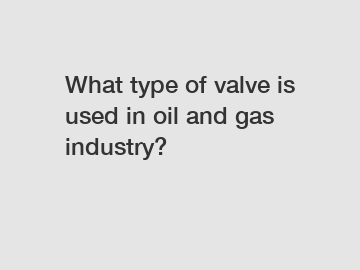What type of valve is used in oil and gas industry?
What Type of Valve is Used in the Oil and Gas Industry?
The oil and gas industry relies heavily on various types of valves for the successful extraction, transport, and processing of these valuable resources. Valves play a crucial role in controlling the flow, pressure, and direction of oil and gas, ensuring efficiency, safety, and reliability. This article will explore the different types of valves commonly used in the oil and gas industry and their specific applications.
Ball Valves.

Ball valves are one of the most commonly used types of valves in the oil and gas industry. These valves have a spherical closure unit that allows for efficient control of flow. Ball valves offer quick, quarter-turn operation and excellent shut-off capabilities, making them ideal for use in high-pressure applications. They can handle a wide range of operating conditions and are suitable for both onshore and offshore applications.
Gate Valves.
Gate valves are another commonly used valve type in the oil and gas industry. These valves feature a sliding gate that allows or blocks the flow of oil and gas. Gate valves are known for their tight sealing capabilities and low pressure drop across the valve. They are commonly used in applications where a straight-line flow of fluid and minimum restriction is required. However, gate valves are not suitable for regulating flow due to their slower operation compared to other valve types.
Globe Valves.
Globe valves are widely used in the oil and gas industry for their precise control capabilities. These valves have a spherical body with an internal baffle and a movable plug or disc that regulates the flow. Globe valves offer excellent throttling characteristics and can effectively control the flow rate, making them suitable for applications that require precise flow control. They are commonly used in systems where fine adjustments of flow are necessary.
Check Valves.
Check valves, or non-return valves, are crucial in preventing backflow in the oil and gas industry. These valves permit the flow in only one direction while preventing reverse flow. Check valves are designed to automatically open and close with the pressure of the fluid, ensuring that oil and gas flow in the desired direction and minimizing the risk of damage to equipment. They are commonly used in pipelines, pump stations, and other critical oil and gas infrastructure.
Butterfly Valves.
Butterfly valves are known for their compact design and ease of operation. These valves consist of a circular disc that rotates to control the flow of oil and gas. Butterfly valves offer quick and quarter-turn operation, making them suitable for applications that require rapid flow shut-off. They have low-pressure drop characteristics and are commonly used in large diameter pipelines, storage tanks, and processing units.
Conclusion.
In conclusion, the oil and gas industry relies on a variety of valve types to ensure the efficient and safe extraction, transport, and processing of oil and gas resources. Ball valves, gate valves, globe valves, check valves, and butterfly valves each offer unique characteristics and are specifically designed to meet different requirements. Understanding the specific applications of these valves is crucial in selecting the right valve for optimal performance and safety in oil and gas operations.
If you have further questions about the types of valves used in the oil and gas industry or require assistance in choosing the right valve for your specific needs, please do not hesitate to contact us. Our team of experts is ready to provide you with the necessary guidance and support.
For more information, please visit high quality slab gate valve, Top Entry Trunnion Mounted Ball Valve, API 602 Forged Steel Gate Valve.
140
0
0


Comments
All Comments (0)